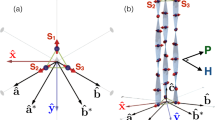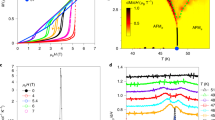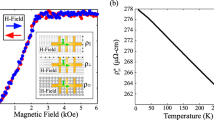Abstract
Chirality, a foundational concept throughout science, may arise at ferromagnetic domain walls1 and in related objects such as skyrmions2. However, chiral textures should also exist in other types of ferroic materials, such as antiferromagnets, for which theory predicts that they should move faster for lower power3, and ferroelectrics, where they should be extremely small and possess unusual topologies4,5. Here, we report the concomitant observation of antiferromagnetic and electric chiral textures at domain walls in the room-temperature ferroelectric antiferromagnet BiFeO3. Combining reciprocal and real-space characterization techniques, we reveal the presence of periodic chiral antiferromagnetic objects along the domain walls as well as a priori energetically unfavourable chiral ferroelectric domain walls. We discuss the mechanisms underlying their formation and their relevance for electrically controlled topological oxide electronics and spintronics.
This is a preview of subscription content, access via your institution
Access options
Access Nature and 54 other Nature Portfolio journals
Get Nature+, our best-value online-access subscription
$29.99 / 30 days
cancel any time
Subscribe to this journal
Receive 12 print issues and online access
$259.00 per year
only $21.58 per issue
Buy this article
- Purchase on Springer Link
- Instant access to full article PDF
Prices may be subject to local taxes which are calculated during checkout




Similar content being viewed by others
Data availability
All relevant data are available from the authors and/or are included with the manuscript.
Change history
12 November 2019
A Correction to this paper has been published: https://doi.org/10.1038/s41563-019-0558-2
References
Emori, S., Bauer, U., Ahn, S.-M., Martinez, E. & Beach, G. S. D. Current-driven dynamics of chiral ferromagnetic domain walls. Nat. Mater. 12, 611–616 (2013).
Fert, A., Reyren, N. & Cros, V. Magnetic skyrmions: advances in physics and potential applications. Nat. Rev. Mater. 2, 17031 (2017).
Barker, J. & Tretiakov, O. A. Static and dynamical properties of antiferromagnetic skyrmions in the presence of applied current and temperature. Phys. Rev. Lett. 116, 147203 (2016).
Nahas, Y. et al. Discovery of stable skyrmionic state in ferroelectric nanocomposites. Nat. Commun. 6, 8542 (2015).
Pereira Gonçalves, M. A., Escorihuela-Sayalero, C., Garca-Fernández, P., Junquera, J. & Íñiguez, J. Theoretical guidelines to create and tune electric skyrmion bubbles. Sci. Adv. 5, eaau7023 (2019).
Jungwirth, T., Marti, X., Wadley, P. & Wunderlich, J. Antiferromagnetic spintronics. Nat. Nanotechnol. 11, 231–241 (2016).
Wadley, P. et al. Electrical switching of an antiferromagnet. Science 351, 587–590 (2016).
Smolenskii, G. A. & Chupis, I. E. Ferroelectromagnets. Sov. Phys. Usp. 25, 475–493 (1982).
Dzyaloshinsky, I. A thermodynamic theory of ‘weak’ ferromagnetism of antiferromagnetics. J. Phys. Chem. Solids 4, 241–255 (1958).
Seidel, J. et al. Conduction at domain walls in oxide multiferroics. Nat. Mater. 8, 229–234 (2009).
Van Aert, S. et al. Direct observation of ferrielectricity at ferroelastic domain boundaries in CaTiO3 by electron microscopy. Adv. Mater. 24, 523–527 (2012).
Wei, X.-K. et al. Ferroelectric translational antiphase boundaries in nonpolar materials. Nat. Commun. 5, 3031 (2014).
Bhattacharya, K. The material is the machine. Science 307, 53–54 (2005).
Catalan, G. & Scott, J. F. Physics and applications of bismuth ferrite. Adv. Mater. 21, 2463–2485 (2009).
Hannon, J. P., Trammell, G. T., Blume, M. & Gibbs, D. X-ray resonance exchange scattering. Phys. Rev. Lett. 61, 1245–1248 (1988).
Hill, J. P. & McMorrow, D. F. X-ray resonant exchange scattering: polarization dependence and correlation function. Acta Crystallogr. A 52, 236–244 (1996).
van der Laan, G. Soft X-ray resonant magnetic scattering of magnetic nanostructures. Comptes Rendus Phys. 9, 570–584 (2008).
Lovesey, S. W. & van der Laan, G. Resonant X-ray diffraction from chiral electric-polarization structures. Phys. Rev. B 98, 155410 (2018).
Shafer, P. et al. Emergent chirality in the electric polarization texture of titanate superlattices. Proc. Natl Acad. Sci. USA 115, 915–920 (2018).
Cherifi-Hertel, S. et al. Non-Ising and chiral ferroelectric domain walls revealed by nonlinear optical microscopy. Nat. Commun. 8, 15768 (2017).
Waterfield Price, N. et al. Coherent magnetoelastic domains in multiferroic BiFeO3 films. Phys. Rev. Lett. 117, 177601 (2016).
Lebeugle, D. et al. Electric-field-induced spin flop in BiFeO3 single crystals at room temperature. Phys. Rev. Lett. 100, 227602 (2008).
Johnson, R. D. et al. X-ray imaging and multiferroic coupling of cycloidal magnetic domains in ferroelectric monodomain BiFeO3. Phys. Rev. Lett. 110, 217206 (2013).
Dürr, H. A. et al. Chiral magnetic domain structures in ultrathin FePd films. Science 284, 2166–2168 (1999).
Mostovoy, M. Ferroelectricity in spiral magnets. Phys. Rev. Lett. 96, 067601 (2006).
Rondin, L. et al. Magnetometry with nitrogen-vacancy defects in diamond. Rep. Prog. Phys. 77, 056503 (2014).
Gross, I. et al. Real-space imaging of non-collinear antiferromagnetic order with a single-spin magnetometer. Nature 549, 252–256 (2017).
Tranchida, J., Plimpton, S. J., Thibaudeau, P. & Thompson, A. P. Massively parallel symplectic algorithm for coupled magnetic spin dynamics and molecular dynamics. J. Comput. Phys. 372, 406–425 (2018).
BrunoP., DugaevV. K. & TaillefumierM. Topological Hall effect and Berry phase in magnetic nanostructures. Phys. Rev. Lett. 93, 096806 (2004).
Nagaosa, N. & Tokura, Y. Emergent electromagnetism in solids. Phys. Scr. T146, 014020 (2012).
Jaouen, N. et al. An apparatus for temperature-dependent soft X-ray resonant magnetic scattering. J. Synchrotron Radiat. 11, 353–357 (2004).
Joly, Y., Collins, S. P., Grenier, S., Tolentino, H. C. N. & De Santis, M. Birefringence and polarization rotation in resonant x-ray diffraction. Phys. Rev. B 86, 220101 (2012).
Haverkort, M. W., Hollmann, N., Krug, I. P. & Tanaka, A. Symmetry analysis of magneto-optical effects: the case of X-ray diffraction and X-ray absorption at the transition metal L2,3 edge. Phys. Rev. B 82, 094403 (2010).
Rondin, L. et al. Nanoscale magnetic field mapping with a single spin scanning probe magnetometer. Appl. Phys. Lett. 100, 153118 (2012).
Rondin, L. et al. Magnetometry with nitrogen-vacancy defects in diamond. Rep. Prog. Phys. 77, 056503 (2014).
Plimpton, S. Fast parallel algorithms for short-range molecular dynamics. J. Comput. Phys. 117, 1–19 (1995).
Tranchida, J., Plimpton, S. J., Thibaudeau, P. & Thompson, A. P. Massively parallel symplectic algorithm for coupled magnetic spin dynamics and molecular dynamics. J. Comput. Phys. 372, 406 (2018).
Acknowledgements
We thank H. Popescu for assistance during the synchrotron runs, A. Barbier for discussions regarding diffraction and Y. Joly and G. van der Laan for discussions about the theoretical aspects of resonant X-ray scattering. We also acknowledge the company QNAMI for providing all-diamond scanning tips containing single NV defects. V.J. acknowledges financial support by the European Research Council (ERC-StG-2014, Imagine) and the EU Quantum Flagship project ASTERIQS (820394). The authors also acknowledge support from the French Agence Nationale de la Recherche (ANR) through projects Multidolls, PIAF and SANTA well as the ‘Programme Transversal CEA ACOSPIN and ELSA’. This work was also supported by a public grant overseen by the ANR as part of the ‘Investissement d’Avenir’ programme (LABEX NanoSaclay, ref. ANR-10-LABX-0035).
Author information
Authors and Affiliations
Contributions
J.-Y.C., M.V. and N.J. planned the REXS experiment and carried it out with C.B. V.G. and S.F. prepared the samples and carried out the PFM measurements. B.D., D.K. and P.M. carried out the neutron measurements, while W.A., I.G., A.F. and V.J. carried out the NV magnetometry. T.C., J.T. and P.T. wrote, optimized and ran the simulation code. All authors participated in scientific discussions.
Corresponding author
Ethics declarations
Competing interests
The authors declare no competing interests.
Additional information
Publisher’s note Springer Nature remains neutral with regard to jurisdictional claims in published maps and institutional affiliations.
Supplementary information
Supplementary Information
Supplementary Figs. 1–6.
Rights and permissions
About this article
Cite this article
Chauleau, JY., Chirac, T., Fusil, S. et al. Electric and antiferromagnetic chiral textures at multiferroic domain walls. Nat. Mater. 19, 386–390 (2020). https://doi.org/10.1038/s41563-019-0516-z
Received:
Accepted:
Published:
Issue Date:
DOI: https://doi.org/10.1038/s41563-019-0516-z
This article is cited by
-
Revealing emergent magnetic charge in an antiferromagnet with diamond quantum magnetometry
Nature Materials (2024)
-
Switching the spin cycloid in BiFeO3 with an electric field
Nature Communications (2024)
-
Voltage-based magnetization switching and reading in magnetoelectric spin-orbit nanodevices
Nature Communications (2024)
-
Evolution of anisotropic magnetic properties through helix-to-fan transition in helical antiferromagnetic EuCo2As2
Communications Physics (2023)
-
Self-organization of ferroelectric domains induced by water and reinforced via ultrasonic vibration
Communications Materials (2023)



